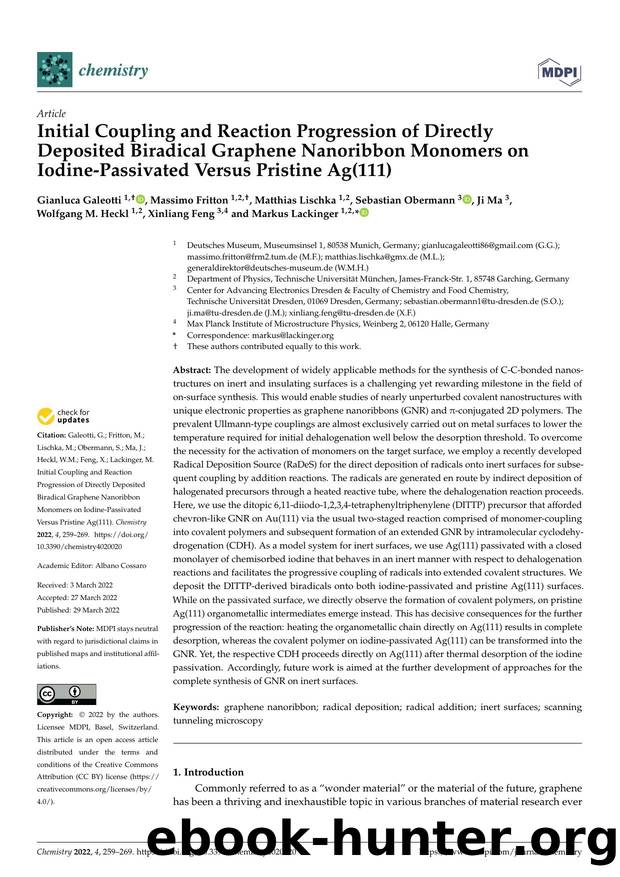Initial Coupling and Reaction Progression of Directly Deposited Biradical Graphene Nanoribbon Monomers on Iodine-Passivated Versus Pristine Ag(111) by unknow

Author:unknow
Format: pdf
Tags: The development of widely applicable methods for the synthesis of C-C-bonded nanostructures on inert and insulating surfaces is a challenging yet rewarding milestone in the field of on-surface synthesis. This would enable studies of nearly unperturbed covalent nanostructures with unique electronic properties as graphene nanoribbons (GNR) and -conjugated 2D polymers. The prevalent Ullmann-type couplings are almost exclusively carried out on metal surfaces to lower the temperature required for initial dehalogenation well below the desorption threshold. To overcome the necessity for the activation of monomers on the target surface, we employ a recently developed Radical Deposition Source (RaDeS) for the direct deposition of radicals onto inert surfaces for subsequent coupling by addition reactions. The radicals are generated en route by indirect deposition of halogenated precursors through a heated reactive tube, where the dehalogenation reaction proceeds. Here, we use the ditopic 6,11-diiodo-1,2,3,4-tetraphenyltriphenylene (DITTP) precursor that afforded chevron-like GNR on Au(111) via the usual two-staged reaction comprised of monomer-coupling into covalent polymers and subsequent formation of an extended GNR by intramolecular cyclodehydrogenation (CDH). As a model system for inert surfaces, we use Ag(111) passivated with a closed monolayer of chemisorbed iodine that behaves in an inert manner with respect to dehalogenation reactions and facilitates the progressive coupling of radicals into extended covalent structures. We deposit the DITTP-derived biradicals onto both iodine-passivated and pristine Ag(111) surfaces. While on the passivated surface, we directly observe the formation of covalent polymers, on pristine Ag(111) organometallic intermediates emerge instead. This has decisive consequences for the further progression of the reaction: heating the organometallic chain directly on Ag(111) results in complete desorption, whereas the covalent polymer on iodine-passivated Ag(111) can be transformed into the GNR. Yet, the respective CDH proceeds directly on Ag(111) after thermal desorption of the iodine passivation. Accordingly, future work is aimed at the further development of approaches for the complete synthesis of GNR on inert surfaces., graphene nanoribbon; radical deposition; radical addition; inert surfaces; scanning tunneling microscopy
Download
This site does not store any files on its server. We only index and link to content provided by other sites. Please contact the content providers to delete copyright contents if any and email us, we'll remove relevant links or contents immediately.
Whiskies Galore by Ian Buxton(41879)
Introduction to Aircraft Design (Cambridge Aerospace Series) by John P. Fielding(33064)
Rewire Your Anxious Brain by Catherine M. Pittman(18553)
Craft Beer for the Homebrewer by Michael Agnew(18140)
Cat's cradle by Kurt Vonnegut(15184)
Sapiens: A Brief History of Humankind by Yuval Noah Harari(14252)
Leonardo da Vinci by Walter Isaacson(13182)
The Tidewater Tales by John Barth(12608)
Thinking, Fast and Slow by Kahneman Daniel(12073)
Underground: A Human History of the Worlds Beneath Our Feet by Will Hunt(12024)
The Radium Girls by Kate Moore(11921)
The Art of Thinking Clearly by Rolf Dobelli(10221)
A Journey Through Charms and Defence Against the Dark Arts (Harry Potter: A Journey Throughâ¦) by Pottermore Publishing(9232)
Mindhunter: Inside the FBI's Elite Serial Crime Unit by John E. Douglas & Mark Olshaker(9201)
Tools of Titans by Timothy Ferriss(8218)
Wonder by R. J. Palacio(8010)
Turbulence by E. J. Noyes(7936)
Change Your Questions, Change Your Life by Marilee Adams(7635)
Nudge - Improving Decisions about Health, Wealth, and Happiness by Thaler Sunstein(7615)
